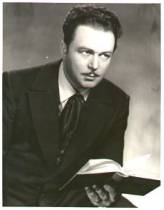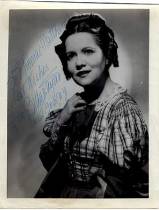Откликаясь на пожелания трудящихся, хочу предложить довольно
редкую запись «Богемы» Пуччини с участием моего любимого тенора Ферруччо
Тальявини и сопрано Биду Сайан. Живая запись со сцены Метрополитен 31.01.1948.
Битрейт довольно низкий (104-160 кбит/сек), но чем богаты...
From Wikipedia,
the free encyclopedia:
Giuseppe
Antonicelli (1897 -
10 March 1980) was an Italian conductor who was highly active with Italy's
leading opera
houses from the
1920s through the 1950s. Among the houses he conducted at were, La Scala in
Milan, the Teatro
Regio di Torino in
Naples, La Fenice in Venice, the Teatro Donizetti in Bergamo, the Teatro Nuovo in Turin, and the
Teatro Lirico Giuseppe Verdi in Trieste. He also conducted a total of 158
performances at the Metropolitan Opera in New York City in 1948-1950. 
Ferruccio
Tagliavini
(Cavazzoli, Reggio Emilia, 14 August 1913 - Reggio Emilia, 29 January 1995) was an Italian operatic tenor mainly
active in the 1940s and 1950s. Tagliavini was hailed as the heir apparent to Tito Schipa and Beniamino Gigli in the lyric-opera repertory due to the
exceptional beauty of his voice, but he did not sustain his great early promise
across the full span of his career.
Tagliavini
studied in Parma with Italo Brancucci and in Florence and
perplexingly with Amedeo Bassi,
a well-known dramatic Verismo and Wagnerian Italian tenor of the pre-World War
I era whose voice (as recorded) could not be more unlike Tagliavini's (see
M.Scott Record of Singing 1978). It was also in Florence that he made his
professional debut in 1938 as Rodolfo in La bohème.
He swiftly
gained recognition as one of the leading tenore di grazia of his time in operas such as Il barbiere di Siviglia, L'elisir d'amore, Don Pasquale, La Sonnambula, Lucia di Lammermoor, Rigoletto, La Traviata, Manon, Werther, L'amico Fritz and L'arlesiana.
Debuts at
many of the world's major opera houses ensued. They included: La Scala, Milan, in
1942; the Teatro Colón, Buenos Aires, in 1946; the Metropolitan Opera, New York City, in 1947 (as Rodolfo in La
bohème); the San Francisco Opera in 1948; the Royal Opera House, Covent Garden, London, in 1950; and, finally, the Paris Opéra in 1951.
During the
1950s, Tagliavini took on heavier roles such as Riccardo in Un ballo in maschera, Cavaradossi in Tosca
and Faust in Mefistofele; but the quality of his voice
suffered as a consequence.
Tagliavini
retired from the stage in 1965. He continued, however, to give recitals until
the mid-1970s. He left behind an impressive discography. The finest of his
recordings are those that he made of operatic arias during his heyday in the
1940s. In them, one can fully appreciate his remarkable skill at soft, or mezza
voce, singing. He also made a few opera films, notably Il barbiere di
Siviglia in 1946 with Tito Gobbi and Italo Tajo.
Tagliavini
married the soprano Pia Tassinari in 1941. He made several recordings
with her and they appeared together often on stage. There is a recording
available of them singing Massenet's opera Werther.

Bidú
Sayão (May 11,
1902 – March 12, 1999) was a Brazilian opera
soprano. One of Brazil's most famous musicians, Sayão was a leading artist of
the Metropolitan Opera in New York City from 1937 to 1952.
Bidú Sayão
was born Balduína de Oliveira Sayão to a cultured family in Botafogo,
Rio de Janeiro. Her father died when she was five years old and her mother
struggled to support her daughter's costly pursuit of a singing career. At the
age of only eighteen, the gifted Bidú Sayão made her major opera debut in Rio
de Janeiro. Her acclaimed performance led to an opportunity to study with the
famous Elena Teodorini, first in Brazil and then in Romania; and then to study with the renowned Polish tenor and tutor, Jean de Reszke, in Nice. During
the mid 1920s and early 1930s, she performed in Rome, Buenos Aires, Paris, as
well as in her native Brazil. While at the Teatro Costanzi in Rome, she met
impresario Walter Mocchi (1870–1955). After his wife, soprano Emma Carelli, died in 1928, the two became romantically
involved and were married. However, it did not last and in 1935 Sayão married
the Italian baritone, Giuseppe Danise (1883–1963).
In 1930,
she debuted at the Teatro alla Scala in Milan, and
in the next year she sang a successful Juliette, in Gounod's Roméo et Juliette, at the Paris
Opera. In the same
year, she gained a great success with her debut at the Opéra Comique as Lakmé. She soon became one of the leading lyric
coloratura sopranos in Europe, especially in Italy and France. Her repertoire
included Lucia di Lammermoor, Amina in La sonnambula, Elvira in I puritani, Zerbinetta in Ariadne auf Naxos and Cecilia in Il Guarany, among other roles.
Metropolitan
Opera
Bidú Sayão
made her U.S. debut in a recital at Town Hall in New York City on December 30, 1935. Her U.S. operatic debut
followed not long thereafter, on January 21, 1936, when she and Danise sang in
the penultimate production of the Washington National Opera, a semi-professional company not
associated with its modern namesake; the performance, of Léo Delibes's Lakmé, was marred by a fractious dispute in which
the orchestra musicians declined to play without payment in cash, and
ultimately the performance was accompanied by a portable organ, with some
singers appearing in costume and some in street clothes owing to a similar
demand by the stage hands and costume man. Altogether more dignified was her
performance a few months later with the New York Philharmonic at Carnegie Hall singing La Demoiselle élue by Debussy. Her performance was under the baton of Arturo Toscanini, who would become her greatest supporter and
lifelong friend. She sang her first performance at the Metropolitan Opera as Manon on
February 13, 1937, replacing the Spanish soprano Lucrezia Bori. The critics, including Olin Downes of the New York Times, raved about her performance and within a few
weeks she was given the lead in La traviata, followed soon thereafter by Mimì in La bohème. She also contributed to the Mozart revival at the Metropolitan Opera, becoming the pre-eminent Zerlina (Don Giovanni) and Susanna (The Marriage of Figaro) of her generation.
As the
favorite singer of Brazilian composer Heitor Villa-Lobos, she had an artistic partnership with him that
lasted many years and made a number of recordings of his compositions,
including a famous recording of the Bachiana
Brasileira No. 5.
Bidú Sayão
and her husband Giuseppe Danise purchased an oceanfront property in Lincolnville, Maine. After fifteen years with the Metropolitan
Opera, she gave her last performance in 1952, choosing to retire from opera
while still at the top of her form. For the next two years she was a guest
performer throughout the U.S., but in 1957 she decided to retire completely
from public performance; two years after that she made her final recording as
the soprano soloist on Villa-Lobos's world premiere stereo recording of his
cantata Forest of the Amazon with the composer conducting the Symphony
of the Air.
Following
the death of her husband in 1963, Bidú Sayão lived a quiet life at her home in Maine. She
returned to visit Brazil a last time in 1995, for a tribute to her during the Carnival in Rio de Janeiro, and died a few years later at the Penobscot
Bay Medical Center in Rockport, Maine. Her ashes were scattered across the bay in
front of her home.
Although
Brazilians have always been strong patrons of the opera, at the time Bidú Sayão
was struggling to launch her career there was little in the way of government
assistance for aspiring singers; throughout her life she spoke about this lack
of support. Following her last visit to her homeland, the government prepared
plans to honor her memory. In 2000 the Bidu Sayão International Vocal
Competition was
established to promote Brazilian operatic talent through a world-class competition.
Bidú
Sayão's portrait hangs in the lobby at the Metropolitan Opera House in New York
City.
Итак:
Metropolitan
Opera House
January 31, 1948 Matinee Broadcast
PUCCINI - LA BOHÈME
Mimì......... ......... .. Bidú Sayao
Rodolfo..... ......... ... Ferruccio
Tagliavini
Musetta..... ......... ... Mimi Benzell
Marcello.... ......... ... John
Brownlee
Schaunard...
......... ...Hugh Thompson
Colline..... ......... ... Nicola
Moscona
Benoit...... ......... ... Salvatore
Baccaloni
Alcindoro... ......... ... Salvatore
Baccaloni
Parpignol... ......... ... Lodovico
Oliviero
Sergeant.... ......... ... Lawrence
Davidson
Conductor... ......... ...Giuseppe Antonicelli
| 
